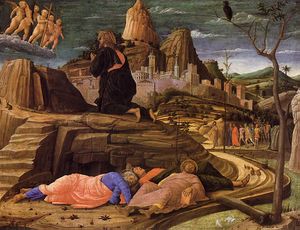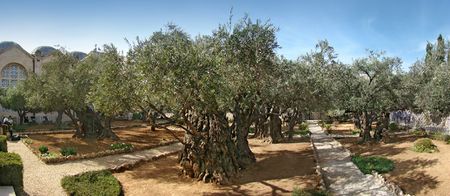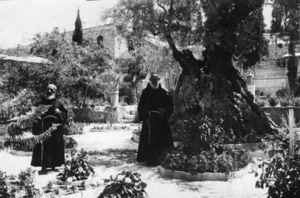گثسمني
31°46′46″N 35°14′25″E / 31.779402°N 35.240197°E
گـِثسـِمـَني (Gethsemane ؛ /ɡɛθˈsɛməni/؛ gheth-SEM-ə-nee؛ باليونانية قديمة: Γεθσημανή, Gethsēmanḗ؛ بالعبرية: גת שמנים؛ سريانية: ܓܕܣܡܢ) هي حديقة عند سفح جبل الزيتون في القدس حيث، حسب الأناجيل الأربعة للعهد الجديد، تعرض المسيح للعذاب في الحديقة والاعتقال في الليلة السابقة لصلبه. وهي مكان له صدى كبير في المسيحية. ويوجد العديد من بساتين الزيتون ضمن أملاك الكنيسة، وكلها متجاورة لبعضها البعض وتتطابق مع گثسمني الإنجيلية.
أصل الاسم
كلمة گثسمني تظهر في الأصل اليوناني لإنجيل متى[1] and the Gospel of Mark[2] as Γεθσημανή (Gethsēmanḗ). The name is derived from the Aramaic ܓܕܣܡܢ (Gaḏ-Šmānê), meaning "oil press".[3] Matthew 26:36 and Mark 14:32 call it χωρἰον (chōríon), meaning a place or estate. The Gospel of John says Jesus entered a garden (κῆπος kêpos) with his disciples.[4]
الموقع
According to the New Testament it was a place that Jesus and his disciples customarily visited, which allowed Judas Iscariot to find him on the night of his arrest.[5]
There are four[6] locations, all of them at or near the western foot of the Mount of Olives, officially claimed by different denominations to be the place where Jesus prayed on the night he was betrayed.
- The garden at the Catholic Church of All Nations, built over the "Rock of the Agony".
- The location near the Tomb of the Virgin Mary to the north.
- The Greek Orthodox location to the east.
- The Russian Orthodox orchard, next to the Church of Mary Magdalene.
William McClure Thomson, author of The Land and the Book, first published in 1880, wrote: "When I first came to Jerusalem, and for many years afterward, this plot of ground was open to all whenever they chose to come and meditate beneath its very old olive trees. The Latins, however, have within the last few years succeeded in gaining sole possession, and have built a high wall around it. The Greeks have invented another site a little to the north of it. My own impression is that both are wrong. The position is too near the city, and so close to what must have always been the great thoroughfare eastward, that our Lord would scarcely have selected it for retirement on that dangerous and dismal night. I am inclined to place the garden in the secluded vale several hundred yards to the north-east of the present Gethsemane."[7]
All of the foregoing is based on long-held tradition and the conflating of the synoptic accounts of Mark (14:31) and Matthew (26:36) with the Johannine account (John 18:1). Mark and Matthew record that Jesus went to "a place called the oil press (Gethsemane)" and John states he went to a garden near the Kidron Valley. Modern scholarship acknowledges that the exact location of Gethsemane is unknown.[8]
محج

الأساس من النص المقدس
According to Luke 22:43–44, Jesus' anguish on the Mount of Olives (Luke does not mention Gethsemane; Luke 22:39–40) was so deep that "his sweat was as it were great drops of blood falling down to the ground."
بالقرب من قبر مريم
According to the Eastern Orthodox Church tradition, Gethsemane is the garden where the Virgin Mary was buried and was assumed into heaven after her dormition on Mount Zion.[بحاجة لمصدر]
التاريخ
The Garden of Gethsemane became a focal site for early Christian pilgrims. It was visited in 333 by the anonymous "Pilgrim of Bordeaux", whose Itinerarium Burdigalense is the earliest description left by a Christian traveler in the Holy Land. In his Onomasticon, Eusebius of Caesarea notes the site of Gethsemane located "at the foot of the Mount of Olives", and he adds that "the faithful were accustomed to go there to pray".
Eight ancient olive trees growing in the Latin site of the garden may be 900 years old (see § Olive trees).[9]
In 1681 Croatian knights of the Holy Order of Jerusalem, Paul, Antun and James bought the Gethsemane Garden and donated it to the Franciscan community, which owns it to this day. A three-dimensional plate on the right side next to the entrance to the garden describes the aforementioned gift to the community.[10]
أشجار الزيتون
A study conducted by the National Research Council of Italy in 2012 found that several olive trees in the garden are amongst the oldest known to mankind.[11] Dates of 1092, 1166 and 1198 AD were obtained by carbon dating from older parts of the trunks of three trees.[11] DNA tests show that the trees were originally planted from the same parent plant.[11] This could indicate an attempt to keep the lineage of an older individual intact.[12][13] Then again, the three trees tested could have been sprouts reviving from the older roots. "The results of tests on trees in the Garden of Gethsemane have not settled the question of whether the gnarled trees are the very same which sheltered Jesus because olive trees can grow back from roots after being cut down", researchers said.[13]
However, Bernabei writes: "All the tree trunks are hollow inside so that the central, older wood is missing ... In the end, only three from a total of eight olive trees could be successfully dated. The dated ancient olive trees do, however, not allow any hypothesis to be made with regard to the age of the remaining five giant olive trees."[14] Babcox said that the roots of the oldest trees are possibly much older and then points out the traditional claim that the trees are two thousand years old.[15]
الآثار
In 2014, an archaeological survey of the site was conducted by Amit Re'em and David Yeger on behalf of the Israel Antiquities Authority (IAA).[16]
انظر أيضاً
الهامش
- ^ Matthew 26:36 (King James Version); "Holy Bible: Greek New Testament (Scrivener 1894)". Christian Classics Ethereal Library. Archived from the original on 30 August 2008. Retrieved 25 March 2009.
- ^ Mark 14:32 (KJV); "Holy Bible: Greek New Testament (Scrivener 1894)". Christian Classics Ethereal Library. Archived from the original on 21 October 2012. Retrieved 25 March 2009.
- ^ Metzger, Bruce M.; Coogan, Michael D., eds. (1993). The Oxford Companion to the Bible. Oxford, UK: Oxford University Press. p. 253. ISBN 0-19-504645-5.
- ^ John 18:1 (KJV).
- ^ Brown, S. Kent (1992), "Gethsemane", in Ludlow, Daniel H, Encyclopedia of Mormonism, New York: Macmillan Publishing, pp. 542–543, ISBN 0-02-879602-0, OCLC 24502140
- ^ Wycliffe Bible Encyclopedia, "Gethsemane", p.675, 1975, ISBN 0-8024-9697-0
- ^ Thomson, William M. 1806-1894. The Land And the Book. New York: Harper & brothers, 1860.
- ^ The Complete Gospels: Annotated Scholars Version. 1994 by Polebridge Press. p. 108, note on Mt. 26:36
- ^ Paul Maier In the Fullness of Time
- ^ Polic, Peter (21 February 2018). "English: Gethsemane garden plate which describes contribution of Croatian knights in 17th century for granting those gardens to Franciscan monastery". Archived from the original on 11 May 2018 – via Wikimedia Commons.
- ^ أ ب ت "Jerusalem olive trees among oldest in world". Haaretz. Reuters. 20 October 2012. Archived from the original on 31 October 2016.
- ^ Zeller, Harmah. Wild Flowers of the Holy Land
- ^ أ ب Reuters (20 October 2012). "Jerusalem olive trees among oldest in world". Haaretz
- ^ Bernabei, Mauro. "The age of the olive trees in the Garden of Gethsemane." Journal of Archaeological Science 53 (2015): 43–48
- ^ Babcox, Wendy. "Every Olive Tree in the Garden of Gethsemane." Departures in Critical Qualitative Research 3.2 (2014): 111–115
- ^ Israel Antiquities Authority, Excavators and Excavations Permit for Year 2014, Survey Permit # A-7013
أعمال مذكورة
- Taylor, Joan E., "The Garden of Gethsemane", Biblical Archaeology Review 21/4 (July/August 1995) 26–35: www.bib-arch.org/online-exclusives/Easter-03.asp
وصلات خارجية
- Pages using gadget WikiMiniAtlas
- Coordinates on Wikidata
- Articles containing Ancient Greek (to 1453)-language text
- Articles containing عبرية-language text
- Articles containing سريانية الكلاسيكية-language text
- Articles with hatnote templates targeting a nonexistent page
- Articles with unsourced statements from February 2019
- المسيحية في القدس
- جغرافيا القدس
- جغرافيا العهد الجديد
- جبل الزيتون
- New Testament Aramaic words and phrases


